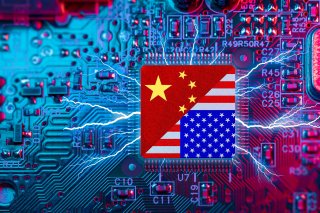
Why America Is Losing the Tech War with China
It is simply too late to try to suppress China. The United States must either spend seriously on research and development, along with industrial policy, or it will lose the race for twenty-first-century technological supremacy.
Western media, for the most part, has ignored a remarkable array of Chinese pilot products in industrial automation, executed primarily by Huawei, the world’s largest maker of telecommunications infrastructure and the target of a global suppression campaign by the United States. Fully automated factories, mines, ports, and warehouses already are in operation, and the first commercial autonomous taxi service is starting up in Beijing. Huawei officials say the company has 10,000 contracts for private 5G networks in China, including 6,000 in factories. Huawei’s cloud division has just launched a software platform designed to help Chinese businesses build proprietary AI systems using their own data.
There’s no indication that the Biden administration’s restrictions on high-end chips and the software and machines that make them have slowed China’s drive for dominance in the so-called Fourth Industrial Revolution—the application of AI to manufacturing, mining, farming, and logistics. Although the fog of tech war makes it hard to evaluate China’s progress with precision, available information points to surprisingly rapid progress in China’s efforts to work around technology restrictions.
The Three Potential Outcomes
China’s single-minded goal is to lead the next wave of industrial technology. Former World Bank Chief Economist Justin Yifu Lin, now a professor at Peking University and a councilor of China’s State Council, wrote in a 2021 book:
China’s 5G technology has become the world leader in the new industrial revolution. In the past few years, the US has repeated its old tricks and suppressed Chinese companies with groundless accusations, using all of its national resources. If the US succeeds in suppressing China by means of a blockade in the new industrial revolution, China will not be able to achieve its second centennial goal. How can China break through the US blockade? It can only do this by working hard to lead the new industrial revolution.
China is leading in the application of AI and high-speed broadband to business productivity. This can have one of three outcomes:
1. The United States and its allies make a concerted effort to leapfrog China and reclaim technological leadership in industry;
2. America and Europe adopt Chinese industrial technology and become followers, as China was a follower of developed markets a generation ago;
3. America continues to lose market share in industry and increases its import dependency, following the United Kingdom’s path of industrial decline.
The first option would require an industrial policy of some kind. America has turned towards such through the CHIPS Act, which has motivated $200 billion in projected investment in semiconductor production, according to the Semiconductor Industry Association. How effective the research and development (R&D) component of the CHIPS Act will be remains to be seen. Whatever the merits and flaws of the legislation, building chip fabs in the United States is justifiable on national security grounds but does not necessarily contribute to the productivity of other industries. On the contrary: the same quality (and even better) chips can be imported at a lower cost from Taiwan and South Korea; TSMC reportedly will sell chips made in the United States at a price 30 percent higherthan the same product made in Taiwan. And beyond chips, the United States has not begun to consider a broader industrial policy, let alone begin to put such a policy into place.
To some extent, the second option—adopting Chinese technology—already is taking hold in increments. As noted below, only American companies that already have large-scale manufacturing operations in China have adopted AI/5G applications, entirely in the auto and related sectors.
The third alternative, continued deindustrialization, is unacceptable.
China’s Chip Dominance and the Failure of U.S. Tech Controls
Western analysts have overestimated the impact of technology controls on China, and underestimated China’s ability to work around them. There is a great deal of confusion about the importance of the latest generation of computer chips, whose narrow gate width allows more transistors to be packed into a single chip. The newest iPhones run on chips with 13 billion transistors; for reference, the computer that took the Apollo capsule to the moon in 1969 had about 64,000. The faster speed and energy efficiency of the newest chips are indispensable for 5G handsets. The graphics processing units (GPUs) produced by Nvidia and AMD make tractable the enormous datasets required for large language models (LLMs), like ChatGPT. But older chips, alone or working in parallel, can handle most business AI applications. More important than raw chip speed is the availability of the right data, the ability to transmit it quickly and conveniently, and the overall system architecture.
After the Trump administration banned sales of high-end U.S. semiconductors to Huawei in 2020, Western media predicted that China’s 5G rollout would grind to a halt. The Nikkei Asian Review wrote, for example: “Huawei Technologies and ZTE, China’s two largest telecoms equipment providers, have slowed down their 5G base station installation in the country, the Nikkei Asian Review has learned, a sign that Washington’s escalating efforts to curb Beijing's tech ambitions are having an effect.”
On the contrary: the number of 5G base stations in China doubled in 2021 to 1.43 million, and rose to 2.31 million in 2022, out of a world total of 3 million. Huawei simply built the 5G base stations with mature chips (with a 28-nanometer gate width rather than the 7-nanometer chips banned by Washington). Energy consumption was higher than optimal, but the system worked. Without access to the newer chips, Huawei’s handset business, the world’s largest in the second quarter of 2020, shrank drastically, because 5G handsets need powerful, energy-efficient processors.
Now it appears that Huawei can design its own high-end chips and manufacture them in China. Chinese research firms report that Huawei will reenter the 5G handset market in the second half of 2023. Reuters reported on July 12 that, “Huawei should be able to procure 5G chips domestically using its own advances in semiconductor design tools along with chipmaking from Semiconductor Manufacturing International Co (SMIC), three third-party technology research firms covering China’s smartphone sector told Reuters.” Caixin Global Dailyreported in March that Huawei had co-developed Electronic Design Automation software with local firms for older 14-nanometer chips. It isn't clear whether SMIC can make enough 7-nanometer chips to meet Huawei's requirements, or whether the reported new 5G chips use another technology, for example, “stacking” two 14-nanometer chips in a “chiplet” to achieve 7-nanometer performance.
Consumer technology like handsets, though, is a subplot. The decisive issue is business productivity. Huawei and other Chinese companies now offer cloud-based AI services along with training and consulting to propagate the new technology to thousands of firms.
Huawei Cloud CEO Zhang Pingan July 7 rolled out a business-centered AI system before the 6th World Artificial Intelligence Conference in Shanghai, with a dismissive nod to ChatGPT: “The Pangu model does not compose poetry, nor does it have time to compose poetry, because its job is to go deep into all walks of life, and help AI add value to all walks of life.” Unlike OpenAI’s LLM, Huawei’s entry will train AI systems for customers in manufacturing, pharmaceutical R&D, mining, railways, finance, and other industries, Zhang said. The platform is powered by Huawei’s own Kunpeng and Ascend AI accelerator chips. Like the American LLMs, Pangu writes computer code, according to Huawei. But “it was designed for industry, and will be dedicated to industry,” Zhang added.
Most of these are embryonic, but with the Pangu system, Huawei Cloud offers its customers “large-scale industry development kits. Through secondary training on customer-owned data, customers can have their own exclusive industry large models,” the company said.
Zhang Pingan added that Huawei has built an AI cloud platform based on its own Kunpeng and Ascend processors, supporting a suite of AI software. Although “Nvidia’s V100 and A100 GPUs remain the most popular GPUs for training Chinese large-scale models,” a recent study notes, “Huawei used its own Ascend 910 processors” to train the Pangu model. Second, China appears able to produce proprietary AI chips like Ascend, although U.S. sanctions continue to prevent it from fabricating its Kirin smartphone chipset in Taiwan. Chinese chipmakers are keeping their cards close to their vests about fabrication capability.
The overriding issue is that industrial systems rarely require the complexity and computing power that ChatGPT applies to composing school essays and Valentine’s Day poems. China can’t import the fastest and most efficient chips with gateways of 7 nanometers or less, let alone the equipment to manufacture them. But it can make 7-nanometer chips with a costlier process, or approximate the performance of the fastest chip by stacking older chips into so-called chiplets, or jerry-rig older chips to approximate the performance of newer ones through clever system architecture.
Think of the railroad in the nineteenth century, which made it profitable to grow large crops far from water transport. This unleashed ripple effects that made the U.S. economy the world’s largest. Whether the train traveled at 40 or 80 miles an hour made a small difference to its impact on the broader economy—what mattered is that the distance could be crossed. The combination of AI and high-speed broadband creates a data highway that will transform the way most businesses run.



Geen opmerkingen:
Een reactie posten